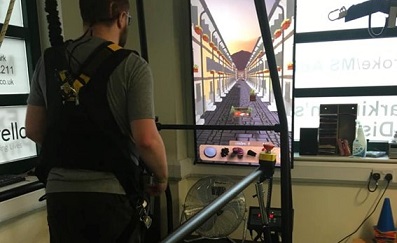Morrello Clinic: Therapist and patient perspectives on the C-Mill
Motek
The Hocoma Clinical and Scientific Affairs Team had the opportunity to interview Rhys Holmes, neurological patient and Dr. Allison Cooper, Clinical Specialist Neurophysiotherapist, at Morrello Clinic to learn more about their personal and professional experience with the C-Mill virtual reality treadmill. Read the full report here.
After having had 20 or so brain operations over just four years, Rhys’ health was finally stabilising. Whilst going through his rehabilitation, he was also diagnosed with superficial siderosis, a rare neurodegenerative condition. His mobility was heavily impaired, and his neurosurgeon had suggested that he use a wheelchair to get around after having to catch him when he had a near fall on the hospital ward. He approached Morrello Clinic in late 2020 after seeing a tweet about them from his local politician.
Dr Allison gave him an initial assessment to get an understanding of his condition and what he needed to work on to improve his mobility. After a few sessions using manual equipment and re-learning to walk with a heel to toe pattern, he was introduced to the C-Mill.
“Wow, what an impressive bit of equipment it is! Straight after putting the harness on, I knew it was going to be a very safe environment to push myself without worrying about falling or getting injured. The width of the belt on the C-Mill is also great, especially when you have adapted a wide based gait to counteract the imbalance of a neurological condition”.
The first application he tried was the C-Gait assessment, which he found “fantastic as it introduces a variety of programs the C-Mill has to offer, from Stepping Stones to Avoiding Obstacles. It’s really fun to use, which takes your mind off the effort you are putting in to improve yourself. The fact it records distinct aspects of data such as weight distribution and gait, is so good to have as a reference to look back at and see how much improvement has been made”.
He also mentioned that the C-Mill has helped him to learn about his own condition, “in that I can see which areas I need to improve on. For example, I always found the Italian Alps game, figure 1 (where you must collect ingredients to make pizzas whilst avoiding the obstacles) exceedingly difficult, as moving side to side and walking with my feet close together, made me very dizzy. This prompted me to focus on practicing heel to toe at home, which has helped me improve. I am now able to use the program at a higher speed, and of course make more pizzas, which is a strangely satisfying goal of mine”.
Now, Rhys is continuing his sessions on the C-Mill and has increased the speed at which he can clearly see that he is “making long term progress.” It is also a huge boost for his mental wellbeing, he says. Although his legs are much stronger and he is now able to walk around the house without falling, he still feels he needs to use the C-Mill every week due to the progressive nature of superficial siderosis. The pain he gets at the back of his head constantly causes vestibular disturbances and using the C-Mill helps to maintain his progress and provides a “huge sense of achievement” in showing him how far he has improved since he first started.
When we asked him what he would say to other patients with the same condition he said: “I am always trying to encourage others with neurological conditions to attend neurophysiotherapy. Improvement is not an overnight process and does take time and commitment, but the benefits are huge. It is also something positive to focus on. My advice to others is to keep going, do not give up, learn about your neuro condition and how to live your best life.”
About the C-Mill treadmill
The C-Mill, developed by Motek, is a force treadmill which provides assessment and training of gait and balance. It uses virtual reality (VR), augmented reality (AR), acoustic cues and force plate technology as part of the therapy process.
The C-Mill uses obstacle avoidance games, dual-tasking applications, realistic virtual reality environments and a variety of balance challenges to encourages gait adaptability strategies. This prepares patients for functional movement in everyday life – all within a safe and controlled environment.
The use of projections means that obstacles and targets no longer have to be set up, leaving more time for patient exercise. Patients take many more steps during C-Mill training, compared to conventional therapy using parallel bars. This increases the intensity, repetition and length of treatment, and is more rewarding and fun for the patient as they recover their stability and gait.
The C-Mill’s unique force plate technology allows for accurate gait analysis and real-time reporting, empowering therapists with meaningful data for tracking progress and giving performance feedback.

